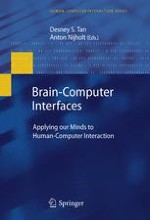2010 | OriginalPaper | Chapter
11. Enhancing Human-Computer Interaction with Input from Active and Passive Brain-Computer Interfaces
Authors : Thorsten O. Zander, Christian Kothe, Sabine Jatzev, Matti Gaertner
Published in: Brain-Computer Interfaces
Publisher: Springer London
Activate our intelligent search to find suitable subject content or patents.
Select sections of text to find matching patents with Artificial Intelligence. powered by
Select sections of text to find additional relevant content using AI-assisted search. powered by
